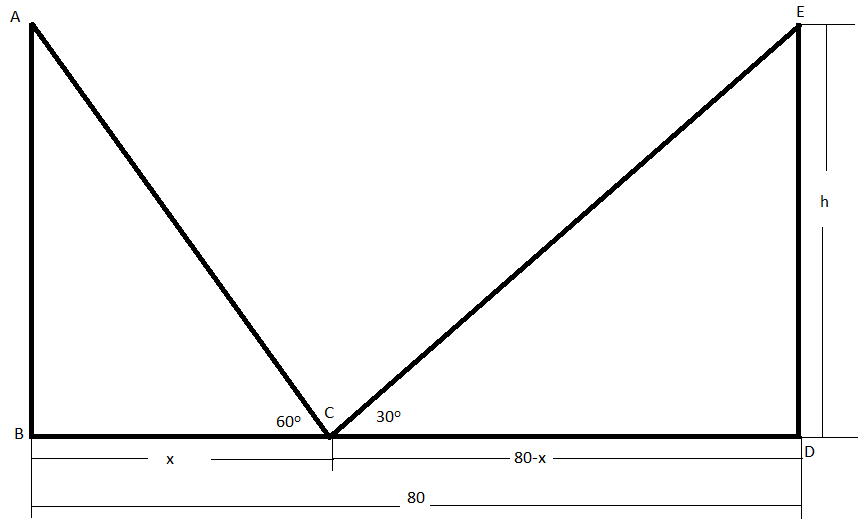
Two poles of equal height are standing opposite to each other on either side of the road which is $80m$ wide. From a point between them on the road, the angles of elevations of the top of the poles are ${{60}^{o}}$ and ${{30}^{o}}$ respectively. Find the height of the poles and the distance of the point from the poles.
Answer
606.9k+ views
Hint: The given question is related to heights and distances. Try to recall the formulae related to trigonometric ratios and values of trigonometric functions for standard angles.
The following formulae will be used to solve the given problem:
(a) $\tan \theta =\dfrac{opposite\,side}{adjacent\,side}$
(b) $\tan \left( {{30}^{o}} \right)=\dfrac{1}{\sqrt{3}}$
(c) $\tan \left( {{60}^{o}} \right)=\sqrt{3}$
Complete step-by-step answer:
Now, considering the information given in the question, we can draw the following figure for better visualization of the problem:

Let $AB$ and $DE$ be the poles of equal height and $BD$ be the road between them. Let the height of the poles be $h$ meter.
In the question, it is given that the width of the road is $80m$ . So, $BD=80$.
We will consider the point $C$ on the line $BD$ such that it is at a distance of $x$ meter from the pole $AB$ . So , the distance of point $C$ from the pole $DE$ will be $(80-x)m$ .
So, $BC=x$ and $CD=80-x$ .
Now, in the question, it is given that the angles of elevation of the top of the poles from point $C$ are ${{60}^{o}}$ and ${{30}^{o}}$.
So, $\measuredangle ACB={{60}^{o}}$ and $\measuredangle ECD={{30}^{o}}$.
Now, we will consider the triangle $\Delta ABC$.
In $\Delta ABC$,
$\tan \left( {{60}^{o}} \right)=\dfrac{h}{x}$
$\Rightarrow \sqrt{3}=\dfrac{h}{x}$
$\Rightarrow h=x\sqrt{3}......(i)$
Now, we will consider the triangle $\Delta ECD$.
In $\Delta ECD$,
$\tan \left( {{30}^{0}} \right)=\dfrac{h}{80-x}$
$\Rightarrow \dfrac{1}{\sqrt{3}}=\dfrac{h}{80-x}$
$\Rightarrow h=\dfrac{80-x}{\sqrt{3}}......(ii)$
Now, both heights are equal, i.e. $(i)=(ii)$ .
So, $x\sqrt{3}=\dfrac{80-x}{\sqrt{3}}$
$\Rightarrow 3x=80-x$
$\Rightarrow 3x+x=80$
$\Rightarrow 4x=80$
$\Rightarrow x=20$
So, the distance of the point $C$ from the pole $AB$ is equal to $20m$and hence, the distance of the point$C$ from the pole $DE$ will be equal to $80-x=80-20=60m$.
Now, we need to find the heights of the pole. From equation$(i)$, we have $h=x\sqrt{3}$.
We know, $x=20$. So, $h=20\sqrt{3}m$.
Hence, the distance of the point from the poles is $20m$ and $60m$ and the height of the poles is $20\sqrt{3}m$.
Note: Students are generally confused between the values of $\tan \left( {{30}^{o}} \right)$ and $\tan \left( {{60}^{o}} \right)$. $\tan \left( {{30}^{o}} \right)=\dfrac{1}{\sqrt{3}}$ and $\tan \left( {{60}^{o}} \right)=\sqrt{3}$. These values should be remembered as they are used in various problems of heights and distances.
The following formulae will be used to solve the given problem:
(a) $\tan \theta =\dfrac{opposite\,side}{adjacent\,side}$
(b) $\tan \left( {{30}^{o}} \right)=\dfrac{1}{\sqrt{3}}$
(c) $\tan \left( {{60}^{o}} \right)=\sqrt{3}$
Complete step-by-step answer:
Now, considering the information given in the question, we can draw the following figure for better visualization of the problem:

Let $AB$ and $DE$ be the poles of equal height and $BD$ be the road between them. Let the height of the poles be $h$ meter.
In the question, it is given that the width of the road is $80m$ . So, $BD=80$.
We will consider the point $C$ on the line $BD$ such that it is at a distance of $x$ meter from the pole $AB$ . So , the distance of point $C$ from the pole $DE$ will be $(80-x)m$ .
So, $BC=x$ and $CD=80-x$ .
Now, in the question, it is given that the angles of elevation of the top of the poles from point $C$ are ${{60}^{o}}$ and ${{30}^{o}}$.
So, $\measuredangle ACB={{60}^{o}}$ and $\measuredangle ECD={{30}^{o}}$.
Now, we will consider the triangle $\Delta ABC$.
In $\Delta ABC$,
$\tan \left( {{60}^{o}} \right)=\dfrac{h}{x}$
$\Rightarrow \sqrt{3}=\dfrac{h}{x}$
$\Rightarrow h=x\sqrt{3}......(i)$
Now, we will consider the triangle $\Delta ECD$.
In $\Delta ECD$,
$\tan \left( {{30}^{0}} \right)=\dfrac{h}{80-x}$
$\Rightarrow \dfrac{1}{\sqrt{3}}=\dfrac{h}{80-x}$
$\Rightarrow h=\dfrac{80-x}{\sqrt{3}}......(ii)$
Now, both heights are equal, i.e. $(i)=(ii)$ .
So, $x\sqrt{3}=\dfrac{80-x}{\sqrt{3}}$
$\Rightarrow 3x=80-x$
$\Rightarrow 3x+x=80$
$\Rightarrow 4x=80$
$\Rightarrow x=20$
So, the distance of the point $C$ from the pole $AB$ is equal to $20m$and hence, the distance of the point$C$ from the pole $DE$ will be equal to $80-x=80-20=60m$.
Now, we need to find the heights of the pole. From equation$(i)$, we have $h=x\sqrt{3}$.
We know, $x=20$. So, $h=20\sqrt{3}m$.
Hence, the distance of the point from the poles is $20m$ and $60m$ and the height of the poles is $20\sqrt{3}m$.
Note: Students are generally confused between the values of $\tan \left( {{30}^{o}} \right)$ and $\tan \left( {{60}^{o}} \right)$. $\tan \left( {{30}^{o}} \right)=\dfrac{1}{\sqrt{3}}$ and $\tan \left( {{60}^{o}} \right)=\sqrt{3}$. These values should be remembered as they are used in various problems of heights and distances.
Recently Updated Pages
Why are manures considered better than fertilizers class 11 biology CBSE

Find the coordinates of the midpoint of the line segment class 11 maths CBSE

Distinguish between static friction limiting friction class 11 physics CBSE

The Chairman of the constituent Assembly was A Jawaharlal class 11 social science CBSE

The first National Commission on Labour NCL submitted class 11 social science CBSE

Number of all subshell of n + l 7 is A 4 B 5 C 6 D class 11 chemistry CBSE

Trending doubts
What is meant by exothermic and endothermic reactions class 11 chemistry CBSE

1 Quintal is equal to a 110 kg b 10 kg c 100kg d 1000 class 11 physics CBSE

Difference Between Prokaryotic Cells and Eukaryotic Cells

What are Quantum numbers Explain the quantum number class 11 chemistry CBSE

What is periodicity class 11 chemistry CBSE

Explain zero factorial class 11 maths CBSE




